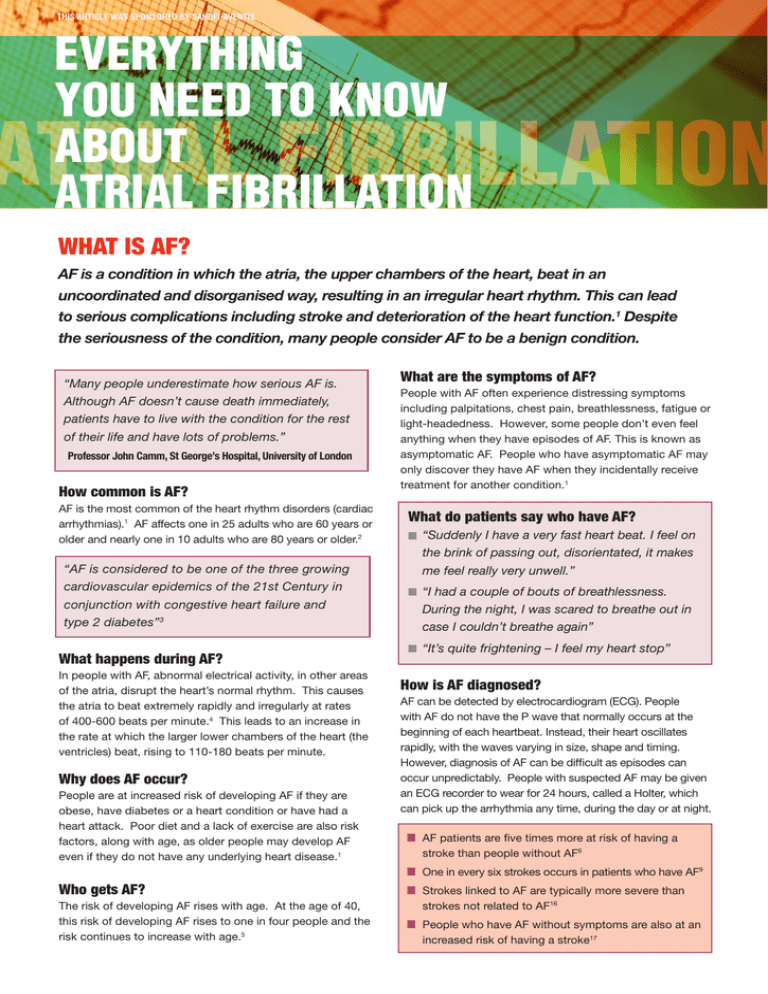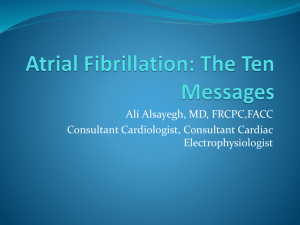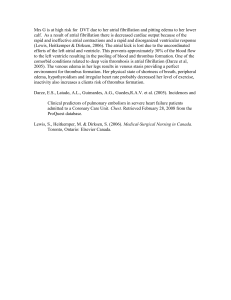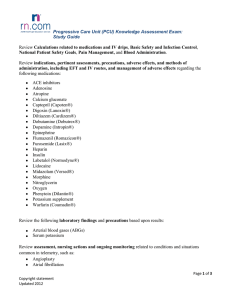everything you need to know about atrial fibrillation
advertisement

THIS ARTICLE WAS SPONSORED BY SANOFI-AVENTIS EVERYTHING YOU NEED TO KNOW ABOUT ATRIAL FIBRILLATION ATRIAL FIBRILLATION WHAT IS AF? F is a condition in which the atria, the upper chambers of the heart, beat in an A uncoordinated and disorganised way, resulting in an irregular heart rhythm. This can lead to serious complications including stroke and deterioration of the heart function.1 Despite the seriousness of the condition, many people consider AF to be a benign condition. “Many people underestimate how serious AF is. Although AF doesn’t cause death immediately, patients have to live with the condition for the rest of their life and have lots of problems.” Professor John Camm, St George’s Hospital, University of London How common is AF? AF is the most common of the heart rhythm disorders (cardiac arrhythmias).1 AF affects one in 25 adults who are 60 years or older and nearly one in 10 adults who are 80 years or older.2 “AF is considered to be one of the three growing cardiovascular epidemics of the 21st Century in conjunction with congestive heart failure and type 2 diabetes”3 What happens during AF? In people with AF, abnormal electrical activity, in other areas of the atria, disrupt the heart’s normal rhythm. This causes the atria to beat extremely rapidly and irregularly at rates of 400-600 beats per minute.4 This leads to an increase in the rate at which the larger lower chambers of the heart (the ventricles) beat, rising to 110-180 beats per minute. Why does AF occur? People are at increased risk of developing AF if they are obese, have diabetes or a heart condition or have had a heart attack. Poor diet and a lack of exercise are also risk factors, along with age, as older people may develop AF even if they do not have any underlying heart disease.1 What are the symptoms of AF? People with AF often experience distressing symptoms including palpitations, chest pain, breathlessness, fatigue or light-headedness. However, some people don’t even feel anything when they have episodes of AF. This is known as asymptomatic AF. People who have asymptomatic AF may only discover they have AF when they incidentally receive treatment for another condition.1 What do patients say who have AF? “Suddenly I have a very fast heart beat. I feel on the brink of passing out, disorientated, it makes me feel really very unwell.” “I had a couple of bouts of breathlessness. During the night, I was scared to breathe out in case I couldn’t breathe again” “It’s quite frightening – I feel my heart stop” How is AF diagnosed? AF can be detected by electrocardiogram (ECG). People with AF do not have the P wave that normally occurs at the beginning of each heartbeat. Instead, their heart oscillates rapidly, with the waves varying in size, shape and timing. However, diagnosis of AF can be difficult as episodes can occur unpredictably. People with suspected AF may be given an ECG recorder to wear for 24 hours, called a Holter, which can pick up the arrhythmia any time, during the day or at night. AF patients are five times more at risk of having a stroke than people without AF6 One in every six strokes occurs in patients who have AF9 Who gets AF? The risk of developing AF rises with age. At the age of 40, this risk of developing AF rises to one in four people and the risk continues to increase with age.5 Strokes linked to AF are typically more severe than strokes not related to AF16 People who have AF without symptoms are also at an increased risk of having a stroke17 ATRIAL FIBRILLATION EVERYTHING YOU NEED TO KNOW ABOUT ATRIAL FIBRILLATION “ There is a mismatch between patients’ experience and the medical view of the condition. Physicians may underestimate the impact of AF on patients’ quality of life. If patients are given more information on their treatment and possible side effects they are more likely to take their medication.” Professor Martin Cowie, Royal Brompton Hospital Normal sinus rhythm. HOW IS AF TREATED? Ensuring people with AF are treated effectively can be a major challenge.1 In Europe, the main guidelines have been developed in 2006, by the European Society of Cardiology, in collaboration with the American Heart Association and American College of Cardiology.1 What is the aim of treatment? ECG of atrial fibrillation The purple arrow indicates a P wave, which is lost in atrial fibrillation. What are the different types of AF? AF can be classified into three types: Paroxysmal – AF recurs and each episode of AF lasts no more than seven days Persistent – AF lasts longer than seven days Permanent – Long-standing AF in which attempts to restore normal heart beat (cardioversion) is either ineffective or has not been attempted How serious is AF? AF is a complex heart condition, which often progresses. AF is also a major cause of patients being admitted to hospital because of the AF itself. The mortality rate of patients with AF is about double that of patients with normal sinus rhythm and is linked to the severity of underlying heart disease.7 AF may also have serious consequences, the most important of which is stroke.6,7,8 One in every six strokes is caused by AF.8 This is because the heart does not pump the blood completely out of the heart’s chambers. Instead, the blood pools and clots and there is a risk that the clot will travel out of the heart and block an artery in the brain. During the past 20 years, there has been a 60 percent increase in the number of people with AF being admitted to hospital as a result of AF. This is probably due to the increasingly ageing population and a rise in heart disease.10 AF therefore presents a significant burden on healthcare budgets.11 The cost of AF AF is an expensive public health problem. In England alone, AF absorbs almost 1 percent of the entire budget of the NHS. In 1995, the direct cost of AF to the NHS was between £244 and £531 million. The main goals of treatment are to restore a normal heart rhythm (cardioversion), restore normal heart rate and to prevent stroke.1 There is an ongoing debate about whether restoring heart rhythm (rhythm control) or restoring heart rate (rate control) is the better approach to AF treatment. Regardless of whether people with AF receive drugs for rhythm or rate control, they should also have anticoagulation therapy to prevent the blood clotting and reduce the risk of having a stroke. Rate or Rhythm control, which is best? Recent studies suggest that controlling heart rhythm is not superior to controlling heart rate, and that rhythm control is more costly and less convenient than rate control. However, young people who experience AF symptoms frequently, or people who have recently developed AF, tend to be treated with rhythm control drugs. It is likely that if safer and more effective anti-arrhythmic drugs were available, these would be used in more people with AF. Generally, doctors prefer drugs that restore and maintain the heart’s rhythm, despite concerns over side effects.14 The limitations of restoring and maintaining normal heart rate is that it does not stop patients having AF, and the AF continues to evolve. As a result, people with AF continue to experience symptoms including an irregular heartbeat, despite a slower heart rate. In addition, drugs used to control heart rate such as beta-blockers and calcium channel blockers are also associated with side effects. The advantages of controlling heart rhythm include reducing the person’s symptoms, improving the person’s physical fitness levels, reducing the person’s risk of stroke, reducing the person’s need for anti-clotting drugs and reducing the person’s risk of death.18 Rhythm control is usually given to younger symptomatic patients while rate control is generally given to older patients. What treatments exist for AF? which can be very serious.12,13 The goal of ongoing drug “ For those patients it helps, catheter AF ablation is a great relief, but it is not a cure, patients who have had an ablation still need drugs to prevent their blood clotting which can cause a stroke.” development is not only to prevent the arrhythmia but also to Professor John Camm, St George’s Hospital, University of London Anti-arrhythmic drugs are widely used to restore the heart’s normal rhythm and prevent AF. These drugs are effective but can also cause serious side-effects including arrhythmias, provide patients with a therapy with fewer side-effects. New anti-arrhythmic drugs are believed to have more benefits and lower risks compared to existing anti-arrhythmic drugs.14 In contrast with drugs that restore the heart’s rhythm, there have been fewer advances with drugs that restore the heart’s rate such as beta-blockers, calcium-channel blockers, digoxin and adenosine.14 What other treatment options exist for AF? Other techniques to restore heart rhythm include cardioversion and ablation. Cardioversion is used to reset and restore sinus rhythm (normal heart rhythm) in people who have persistent AF. It may involve drugs or electric What are the risks of cardioversion and ablation? Restoring the heart rate (cardioversion) carries a risk of stroke unless anti-clotting therapy is initiated before the treatment. The development of new drugs has increased the popularity of drug-based methods of restoring heart rhythm, despite the potential side effects. Drug-based rhythm control therapies do not require the patient to be sedated, which is necessary if electrical stimuli are used to restore heart rhythm. The risk of stroke is the same whether drugs are used to restore heart rhythm or electrical stimuli are used.1 People with AF have impaired quality of life comparable to people who have had a heart attack19 chest pain in patients with heart disease. One third of patients experience significant anxiety or depression20 Catheter ablation is a surgical technique where wires are Ablation is a complicated procedure and can only be successfully performed in highly specialised centres. A single ablation procedure may take three to six hours. For patients who benefit, it is an important procedure, but it is only undertaken when there are clear benefits. As ablation techniques improve, it is likely to be used more widely, but currently ablation is only used with a small number of people with permanent AF, who do not respond to drugs to control the heart rate.14 stimuli, and is often performed when the AF is likely to lead to heart failure, abnormally low blood pressure, or severe passed through a patient’s vein into the heart, so that radiofrequency waves can be used to destroy (ablate) the affected area inside the heart that is causing the abnormal heart rhythm. The procedure is done under a local anaesthetic and with sedation. The patients most likely to benefit from this procedure are those with rapid heart rate during AF episodes that cannot be controlled adequately with drugs.15 People who have ablation need to have a permanent pacemaker implanted to replace the natural pacemaker tissues destroyed during the procedure. Although ablation can be highly effective in controlling the patient’s heart rate, it does not cure AF in all cases. What’s on the horizon? There are a number of drugs under development including nexterone, budiodarone, ranolazine, connexin modulators, dronedarone and vernakalant. None of these drugs are available in the UK at present.14 CONCLUSION Despite the serious health burden caused by AF, there are real advances on the horizon for people with the condition. As Professor John Camm, Head of the Department of Cardiac & Vascular Sciences, St George’s Hospital, University of London, says, “We need earlier and better diagnosis and treatment of AF, improved anti-coagulation and anti-arrhythmics. All of this is within our grasp. There are many therapies that will become available over the next few years. We now need to be more proactive about finding AF and applying these therapies.” ATRIAL FIBRILLATION EVERYTH EVERYTHING YOU NEED TO KNOW ABOUT ATRIAL FIBRILLATION EVERYTHING YOU NEED TO KNOW ABOUT ATRIAL FIBRILLATION GLOSSARY Ablation A procedure in which tissue is removed, usually by vaporisation, using radio waves. The term is often used in the context of laser ablation, a process in which a laser dissolves a material's molecular bonds. See also catheter ablation Anti-coagulation A process in the body whereby a substance (anti-coagulants) stops blood from clotting Anti-arrhythmic drugs A group of products used to suppress abnormal heart rhythms, such as atrial fibrillation, atrial flutter, ventricular tachycardia and ventricular fibrillation Arrhythmia An irregular rhythm of the heart, resulting in the heart beating too slowly, too quickly or irregularly Atria The top two chambers in the heart, which receive blood as it returns to the heart thus completing a circulatory cycle. The ventricle pumps blood out of the heart to start a new cycle Atrial Fibrillation A condition in which the top two chambers of the heart (the atria), beat irregularly due to an abnormal heart rhythm Cardioversion A process which aims to restore an arrhythmic heart to its normal rhythm. It can take two forms: synchonized electrical and pharmacologic cardioversion. Synchonized electrical cardioversion is the application of an electric shock to restore normal heartbeat, whilst pharmacologic cardioversion uses REFERENCES: 1ACC/AHA/ESC 2006 guidelines for the management of patients with atrial fibrillation. European Heart Journal (2006) 27, 1979-2030. 2.Go A.S., Hylek E.M., Phillips K.A., et al. Prevalence of diagnosed atrial fibrillation in adults: national implications for rhythm management and stroke prevention: the AnTicoagulation and Risk Factors in Atrial Fibrillation (ATRIA) Study. JAMA 2001; 285:2370–5. 3.B J Gersh, et al The changing epidemiology of non-valvular atrial fibrillation: the role of novel risk factors Eur Heart Journal, 2005; 7 (supp C) c5 c11 4.Johan E.P. Waktare. Atrial Fibrillation. Circulation 2002;106;14-16. 5.Lloyd-Jones D.M, Wang T.W., Leip E.P, et al. Lifetime Risk for Development of Atrial Fibrillation: The Framingham Heart Study. Circulation. 2004; 110:1042-1046. 6.Wolf P.A., Dawber T.R., Thomas H.E. Jr, et al. Epidemiologic assessment of chronic atrial fibrillation and risk of stroke: the Framingham study. Neurology. 1978; 28: 973-77. 7.Stewart S, Hart C.L., Hole D.J., et al. A population-based study of the long-term risks associated with atrial fibrillation: 20-year follow-up of the Renfrew/Paisley study. Am J Med 2002; 113:359–64. 8.Benjamin E.J., Wolf P.A., D’Agostino R.B., et al. Impact of atrial fibrillation on the risk of death: the Framingham Heart Study. Circulation. 1998; 98: 946-52. 9.Hart R.G, Halperin J.L. Atrial fibrillation and thromboembolism: a decade of progress in stroke prevention. Ann Intern Med 1999; 131:688–95. 47b. 10.Friberg J, Buch P, Scharling H, et al. Rising rates of hospital admissions for atrial fibrillation. Epidemiology 2003;14:666–72. medication such as amiodarone, diltiazem, verapamil and metoprolol for the same purpose Catheter ablation A non-surgical technique that destroys (ablates) parts of the abnormal electrical pathway that is causing arrhythmia. Used to treat conditions such as atrial fibrillation, atrial flutter, supraventricular tachycardias (SVT) and WolffParkinson-White syndrome. The procedure involves placing flexible catheters into blood vessels and using highfrequency electrical impulses to induce the arrhythmia and destroy the causal abnormal tissue Electrocardiogram (ECG) A non-invasive recording of the electrical output of the heart over time using an electrocardiographic device, measured at selectively placed electrodes on the skin. The ECG displays the voltage between pairs of these electrodes, which indicates the overall rhythm of the heart and weaknesses in different parts of the heart muscle Sinus rhythm A term used to describe the normal beating of the heart, as measured by an electrocardiogram (ECG). Sinus rhythm is characterized by a usual rate of anywhere between 60 and100 beats per minute (bpm) Stroke Rapid loss of brain function(s) due to disturbance in the blood supply to the brain (ischemia) leading to an inability of limb movement, speech formation or lack of visual activity 11.National Service Framework for Coronary Heart Disease. Chapter Eight: Arrhythmias and Sudden Cardiac Death. March 2005 12.Doggrell S.A, Hancox J.C. Dronedarone: an amiodarone analogue. Expert Opin Investig Drugs. 2004; 13: 415-26. 13.Waldo A.L, Camm J, de Ruyteret H, et al. Effect of d-sotalol on mortality in patients with left ventricular dysfunction after recent and remote myocardial infarction. The SWORD Investigators. Survival With Oral dSotalol. Lancet 1996;348(9019):7-12. 14.Savelieva I, Camm J. Anti-arrhythmic drug therapy for atrial fibrillation: current anti-arrhythmic drugs, investigational agents, and innovative approaches. Europace (2008) 10, 647–665 15.Wood M.A, Brown-Mahoney C, Kay G.N, et al. Clinical outcomes after ablation and pacing therapy for atrial fibrillation: a meta-analysis. Circulation 2000;101:1138–44. 16.Dulli DA et al. Atrial fibrillation is associated with severe acute ischemic stroke Neuroepidemiology. 2003;22(2):118-23 17.Page RL, et al. Azimilide Supraventricular Arrhythmia Program (ASAP) Investigators. Asymptomatic or “silent” atrial fibrillation: frequency in untreated patients and patients receiving azimilide Circulation 2003;107:1141–1145 18.The atrial fibrillation follow-up investigation of rhythm management (AFFIRM) investigators, A comparison of rate control and rhythm control in patients with atrial fibrillation 2002, NEJM, number 23, volume 347 19.Dorian P, et al. The impairment of health-related quality of life in patients with intermittent atrial fibrillation: implications for the assessment of investigational therapy J Am Coll Cardiol 2000;36:1303–1309 20.Thrall G, et al. Depression, anxiety, and quality of life in patients with atrial fibrillation Chest 2007;132:1259–1264





